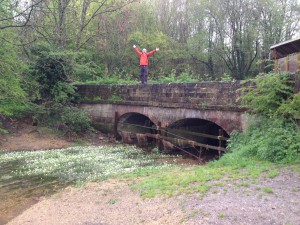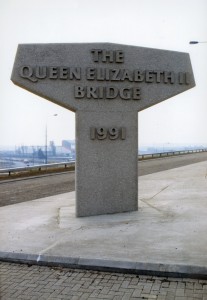Falling Down the Thames Blog 23, 20th August 2014
The Old and The New
In last week’s entry, I indicated that Krista and I would be passing under something like 130 bridges as we paddled the length of the River Thames in 2015. I realize that this isn’t any sort of world record. According to a study by Professor Bob Regan, there are almost 450 bridges in the American city of Pittsburgh alone.
Even so, there are a lot of opportunities to cross the Thames. These include Gosditch Bridge, Hailstone House Footbridge, Old Man’s Footbridge, Black Potts Rail Bridge, and Summerleaze Footbridge.
I am particularly looking forward to passing beneath two bridges along the River Thames; the very first and the very last. These two must count among the oldest and the youngest structures to cross the river.
When Romans invaded Britain nearly two millennia ago, they quickly established a series of paved, all-weather roads. The longest of these roads at more than 350 kilometres was Fosse Way, stretching from Lincoln near England’s east coast to Exeter in the southwest. Fosse Way passed through several major communities including Bath, Leicester and Cirencester. The Romans were great surveyors, and some of their chosen routes are still used today by motorways as major as the A2 and A5. The A433 is a twenty-seven kilometre long stretch of road which follows Fosse Way for about three kilometres just north of the community of Kemble.
Krista and I travelled to Kemble earlier this year to visit the spot traditionally recognized as the head of the River Thames. We walked across the A433/Fosse Road bridge, the very first of 130 bridges that cross the Thames. It is a near certainty that when we go back to the spot next year, we will be dragging our canoe under the bridge, not paddling it. Except at time of very high rainfall, that part of the Thames is dry.
After something like 270 kilometres of paddling, and 128 other bridges, Krista and I will come to the very last bridge over the River Thames. First opened to traffic in 1991, the Queen Elizabeth II Bridge is the only road crossing of the tidal portion of the Thames outside of greater London. It connects Dartford in Kent to Thurrock in Essex. It is a toll bridge, and in excess of 130,000 vehicles cross each day. Nearly 1.5 billion crossings have been made since it first opened. Including its approach viaducts, the Queen Elizabeth II Bridge is over 2800 metres and length, and when we paddle under it, the bridge will soar about sixty metres over our heads.
A teeny old bridge, and a huge new bridge – we will pass under both.
- Glen
Photo credits: Glen on the one of the earlier bridges over the River Thames – Dr Krista Halling; Queen Elizabeth II Bridge – Martin Smith, www.mrsmithworldphotography.com; Queen Elizabeth II Bridge Marker – Richard Kindersley, www.kindersleystudio.co.uk



